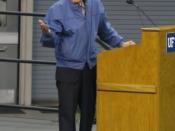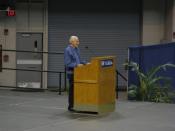Lindsay Bulford
Position Paper
Sam Zarhan
English 241
October **, 2002
Euthanasia and Assisted Suicide
Originally, the term, euthanasia meant "good death" (Manning 1). Terminology of words has been a great factor in the perception of right or wrong. Now, euthanasia, by definition, is the practice of mercifully ending a person's life in order to release the person from an incurable disease, intolerable suffering, or undignified death. Voluntary euthanasia is actually a person asking to die. Nonvoluntary euthanasia is the ending of a person's life that is not mentally able to make an educated request to die. They are by either active or passive euthanasia that these deaths occur. There are special types of euthanasia; they include active euthanasia, and passive euthanasia. Active euthanasia involves painlessly putting a person to death for merciful reasons. A doctor in this situation would give a person a deadly dose of a medication. Passive euthanasia involves the lack of action to prevent death.
A good example of this would be not using a respirator to keep a person alive. Assisted suicide is unlike euthanasia by looking at the fact of who actually causes the death to occur. This "last act- the act without which death would not occur" is the distinguishing factor of the two (Marker 1). The performance of this "last act" would include the swallowing of a drug that a doctor provided for the purpose of death and another example would be triggering the fatal injection after the doctor has put the needle needed into place. Physician assisted suicide is active voluntary euthanasia (Advocates for Better Care 2). The assisting part could be from another individual not automatically a doctor. The many types of euthanasia and assisted suicide are different in a sense but the end the effect of a hastened death...



Hmmm....
I think that this was an ok essay. The fact that you have a bibliography is great. Organization and contend could have a been a little better
2 out of 2 people found this comment useful.